Lowrance Hook Series Complete Review: Hook 3x, 4x, 4, 5, 5x, 7, 7x and 9
If you’re an angler and you love fishing by yourself or on a small boat, then you should really consider the Lowrance Hook series of fish finders. Made specifically for anglers, this fish finder is simple, easy to install, and made to instantly get you to the fish. Some are even made to help you find fish under the ice. Today we’ll be comparing all of the major offerings in this series. That includes the Hook 3x, 4x, 4, 5, and 7, each with their own features and form factors.
Lowrance Hook 3x Review
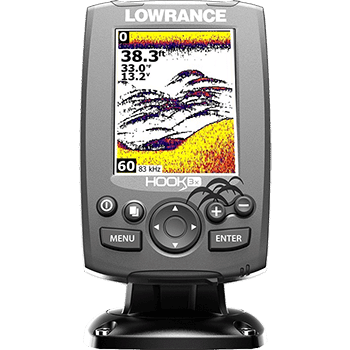
- Display: 3-Inch Display, LED backlight, 320×240 pixels
- Overall Features: Advanced Signal Processing (ASP), Fish ID, Dual Frequency Sonar, Broadband Sounder
- Frequency: 83kHz and 200kHz
- Depth: 300 feet
- GPS Capabilities: No GPS
Starting off with the smallest model, the Hook 3x has a tiny form factor that makes it ideal for small places. While it’s small, the resolution is pretty good and the LED backlighting will ensure that you can easily see everything during the day and night.
You get dual-frequency sonar that lets you choose between 83kHz and 200kHz. The 83kHz scan provides a 60-degree conical search that’s broad, while the 200kHz is a 20-degree cone that’s more detailed. You can switch between the two with the push of a button.
The ASP feature, common to many Lowrance models, reduces the need to adjust settings for clearer images and allows you to see bottom and structure details with ease.

The Fish ID tool is interesting because instead of little arches, it makes them look like fish so it’s easier to visualize what’s around you.
The maximum depth of this fish finder is around 300 feet in freshwater. It may be less in saltwater or if there are inclement conditions. This should be fine for many bodies of water, but you may have trouble with deeper ones.
Dedicated zoom buttons on the unit allow you to zoom in and out up to four times normal view so that you can easily zero in on areas that you’re interested in. All functionality is done through buttons on the unit, it is not a touch screen.
Overall, the Hook 3x model provides a fair number of features for a small unit and it’s perfect if you’re alone and just want a sonar to help guide you. It doesn’t have the power or extra features of other models, but it does a good job with what it has.
Lowrance Hook 4x Review
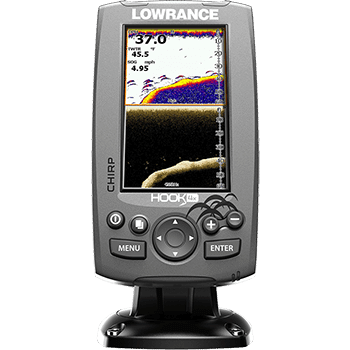
- Display: 4.3 inches, LED backlight, 480×272
- Overall Features: Ice Transducer, CHIRP, Broadband Sounder, DownScan Overlay, ASP, Trackback
- Frequency: 200/83kHz for Broadband, 455kHz for DownScan
- Depth: 300 Feet for DownScan, 1,000 feet for CHIRP
- GPS Capabilities: None
Much like the 3x, this is a tiny unit for tight spaces that packs a good amount of power, but it does falter when it comes to GPS and more advanced imaging types. Perhaps the most unique feature is the ice transducer found in certain models (aptly named the Ice Machine). This allows you to scan deep under ice for fish.

The two main imaging types here are CHIRP sonar and DownScan imaging. CHIRP is a technique that uses several frequencies at once to generate the best possible image in terms of distance and clarity. DownScan gives you a fish’s POV, showing you exactly what it looks like under the water. There’s also ASP to help reduce noise and distortion.
There is also DownScan Overlay, which overlays the findings from your DownScan on top of the CHIRP or regular sonar. This can be used to better figure out what is beneath the surface and if it’s worth stopping for.
Trackback is a recording feature attached to the Lowrance Hook 4x’s sonar that allows you to keep track of your sonar findings. Everything is saved to the SD card (you are free to put in new ones for additional memory). You can scroll back through the sonar images so that you can study an area. This will help you discover new fishing spots.
You can set the display to have three panels, which is great in larger models, but things feel a little cramped here due to the small size. It’s a nice feature to have, but you’ll likely set it to just one panel to maximize the space.
The backlight here is fairly standard and helps you see the screen regardless of lighting conditions. One of the unique things about it is that the backlight is adjustable, ensuring that it won’t be too bright or dim.
Overall, this is a good fish finder for the price. It’s affordable, able to fit in small spaces, and has a few great features. It suffers from a smaller screen and fewer features than larger models. In general, it’s good for the price, but it lacks the power of larger models.
Lowrance Hook 4 Review
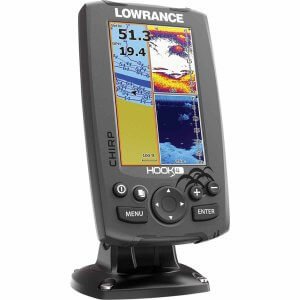
- Display: 4.3 inches, 480×272 resolution, LED backlighting, multicolored
- Overall Features: CHIRP, Broadband Sounder, Mid/High Sonar, DownScan Overlay, ASP, Trackback
- Frequency: 200/83kHz for Broadband, 455kHz for DownScan
- Depth: 300 Feet for DownScan, 1,000 feet for CHIRP
- GPS Capabilities: Yes, uses Insight Genesis for tracking
The Lowrance Hook 4 is very similar to the 4x. The only major difference is the inclusion of the GPS, but the ice transducer has been removed, so it matters which is better for your needs. Most would agree that GPS is more important.
The GPS connects to Insight Genesis, which allows you to download premade maps or generate your own based on your own scans and preferred waypoints. Due to the small size of the fish finder, you can only insert one SD card to save paths.
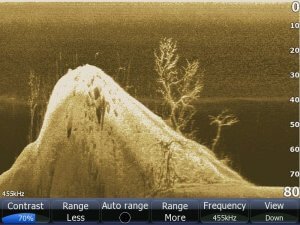
DownScan imaging shows you what everything looks like under the water, giving you a good perspective on all of the fish, vegetation, and other objects down there. You also get DownScan Overlay, which combines the DownScan with the CHIRP findings to give you the clearest imaging possible. Along with the Fish ID feature found with most Lowrance fish finders, you’ll have no problem discovering good fish to reel up.
Switching between different frequencies is incredibly easy. Just push one of the “Page” buttons and the sonar will switch from one frequency to another, allowing you to change on the fly without going through complicated procedures or buttons.
You can also view multiple image types at once by creating up to three panels, but you may want to stick to one or two considering the small size of the display. Speaking of the display, everything is in color to make all the objects and fish easy to visualize.
Overall, this is a good fish finder for the price. Some people might bemoan the lack of the ice transducer, but the inclusion of the GPS more than makes up for it. This is great if you’re going solo or have a small boat and just have a tiny space for a fish finder.
Lowrance Hook2 5 Review

- Display: 5 inches, 800×480 pixel resolution, 16-bit color, LED backlight
- Overall Features: SplitShot Transducer, DownScan Overlay, CHIRP, and traditional sonar scans, ASP, TrackBack, Fish ID
- Frequency: 455/800kHz for DownScan, 83/200kHz for sonar
- Depth: 1,000 feet traditional sonar, 300 feet DownScan
- GPS: Yes, connects to Insight Genesis and has preloaded information for 3,000 lakes, allows you to set waypoints and numerous GPS alarms
Lowrance Hook 5 is a good middle point in the product line between affordability and power. The whole Hook line is based around simplicity, but this one gives a good amount of power that most fishermen will appreciate.
It comes with a few imaging types, most notably DownScan and CHIRP. You get a maximum depth of 1,000 feet and you can switch between several different frequencies to get the best look while balancing clarity and distance. Switching frequencies is as easy as pushing a button, and the buttons are especially good with this model.
Though the display itself is just one inch larger than the 4 and 4x, the unit itself is considerably wider. This is because new, upgraded buttons have been added to the righthand side. These buttons are easy to push, making it simple to select settings, change between frequencies and setup your multiple panels.

You are able to create up to three panels at once to show different imaging types. Since the screen is larger, you should have no problem using all three panels and easily being able to see all the information. There is also information on the screen about water temperature, current speed, and several other important metrics.
GPS is quite good here. It comes preloaded with 3,000 lakes and you can easily use Genesis to generate new maps. Feel free to load a microSD card into the fish finder to upgrade the program and add even more maps and paths. You can also set alarms based on position, depth, water temperature, and so on.
Perhaps the only bad thing is that the Hook 5 doesn’t last too long on batteries. It drains faster than the 4 and 4x, so have spare batteries ready if you’re out on a long fishing trip. Otherwise, this is a great fish finder to have around. It’s got a good, bright screen, multiple imaging types, a respectable GPS and it has everything you need to help find a good fishing spot.
Lowrance Hook2 5x Review

- Display: 5 inches, 800×480 pixel resolution, SolarMax, LED backlight
- Overall Features: SplitShot Transducer, DownScan, CHIRP, traditional sonar
- Frequency: 200kHz sonar, 455/800kHz for DownScan
- Depth: 1,000 feet CHIRP, 300 feet DownScan
- GPS: Yes, GPS Plotting, comes with C-Map, loaded with over 3,000 lakes, allows you to set waypoints
Lowrance Hook2 5x is very similar to the Hook2 5, but there is one very big difference. This version comes with a GPS plotter while the other has a GPS mapping. Both are good, but you’ll find that GPS plotters do a better job of helping you navigate unfamiliar waters. They tend to give you more data, and they are usually more accurate as well.
However, outside of that, this is very similar to the Hook2 5 in almost every other way. You get a very similar display that’s the same size and resolution. It also includes the same backlight. One difference you will notice is the color. This uses SolorMax, which has better contrast and looks better in the harsh sun or dead of night.
You get several imaging types to choose from. There is traditional sonar, CHIRP, and DownScan to see right under the boat. This should be enough for most people as you can easily see the underwater structure and find nearby fish, but it does lack the SideScan of some other Lowrance models. The max depth is 1,000 feet with CHIRP and 300 feet with DownScan, which is a respectable distance especially when you consider the overall price.
If you want an affordable 5-inch fish finder with an enhanced GPS and good scanning distance, then the Hook2 5x fits the bill. It takes everything from the Hook2 5 and makes it better.
Lowrance Hook2 7 Review

- Display: 7 inches, 800×480 pixel resolution, 16-bit color, LED backlight
- Overall Features: SplitShot/Tripleshot Transducer, DownScan Overlay, CHIRP, and traditional sonar scans, ASP, TrackBack, Fish ID
- Frequency: 455/800kHz for DownScan, 83/200kHz for sonar
- Depth: 3,000 feet sonar low range, 1,000 feet sonar mid-range, 300 feet DownScan
- GPS: Yes, connects to Insight Genesis and has preloaded information for 4,000 lakes, allows you to set waypoints and numerous GPS alarms
The Lowrance Hook2 7 is very similar to the Hook2 5, as you can see from the specs. There are a few differences here, like the better depth with the low-range sonar and the larger screen, but overall it basically a larger version of the Hook2 5. It even has the same buttons and overall layout, it’s just a little taller and wider to accommodate the bigger screen.
Now, having a bigger screen does present a few benefits. First of all, the multiview panels are much easier to see, ensuring that you can clearly see all the information on there. Not only that, but you can appreciate the 16-bit color here since the images are so much clearer.
Aside from the good screen, you also get several types of imaging, notably traditional sonar, CHIRP sonar, and DownScan. There’s also DownScan Overlay that overlays the DownScan findings on top of your sonar scans, ensuring that you can easily compare the two. TrackBack allows you to roll back sonar images to help you study an area for changes.
The GPS here is great, and it allows you to store up to 3,000 waypoints and 100 routes, on top of the 3,000 lakes already preloaded in there. Just like the Hook2 5, you can upload and download maps through the use of a microSD card.
The buttons and interface are very easy to use, even a little easier than Hook2 5 because they are slightly bigger. This allows you to very quickly switch between views and activate other tools with only one hand. Within a few buttons pushes you should be able to find what you want or activate the tool that you need.
Overall, this is a good fish finder that gives you all the basics. It truly fulfills the promise of simplicity by giving you all the tools you need along with an easy-to-use interface and a good screen. While you get most of the same benefits with the Hook2 5, the larger screen truly is worth the higher price tag.
Lowrance Hook Reveal 7x Review
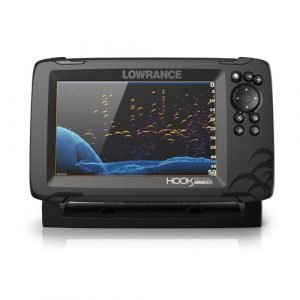
- Display: 7 inches, 800×480 pixel resolution, SolarMax, pure white LED backlight
- Overall Features: SplitShot or TripleShot Transducer, DownScan, SideScan, CHIRP, autotuning sonar, FishReveal
- Frequency: 200kHz sonar, 455/800kHz for CHIRP DownScan and CHIRP SideScan
- Depth: 1,000 feet sonar, 600 feet SideScan, 300 feet DownScan
- GPS: Yes, can come with Genesis Live or C-Map, comes loaded with over 3,000 lakes and allows you to set waypoints
The Lowrance Hook Reveal 7x is the newest addition to the Hook series and it comes with many new features. Not only do you get live mapping now, but you also get FishReveal. This is a handy feature that has been available with other Lowrance models for years, but it’s finally coming to the more affordable Hook series.
This makes it easier to find fish by you. The fish finder analyzes the data and overlays a 2D image over fish. This makes them much easier to spot than trying to interpret the sonar data with your naked eye.
On top of that, you also get DownScan and a stronger SideScan than other previous models. The screen has been updated with a stronger backlight, and the processor ensures faster map redraw rates than with Hook2. You should have no problem mapping your area regardless of your speed.
The 7-inch screen is clear and you can easily open multiple imaging types simultaneously. For example, you can check the DownScan, SideScan, and traditional sonar all at once. This ensures that you can easily see what’s around your boat without having to switch back and forth between imaging types.
You’ll find the GPS and live mapping are incredibly useful here. The GPS is more accurate than ever, which ensures that you can easily find your way, and live mapping works with either preloaded or generated maps.
If you’re looking for an upgraded or just the most advanced entry-level fish finder, then the Lowrance Hook Reveal 7x is exactly what you need.
Lowrance Hook Reveal 9 Review

- Display: 9 inches, 800×480 pixel resolution, SolarMax, pure white LED backlight
- Overall Features: SplitShot or TripleShot Transducer, DownScan, SideScan, CHIRP, autotuning sonar, FishReveal
- Frequency: 200kHz sonar, 455/800kHz for CHIRP DownScan and CHIRP SideScan
- Depth: 1,000 feet sonar, 600 feet SideScan, 300 feet DownScan
- GPS: Yes, can come with Genesis Live or C-Map, comes loaded with over 3,000 lakes and allows you to set waypoints
The Lowrance Hook Reveal 9 has basically all the same features as the Hook Reveal 7. It comes with the same resolution, backlight, transducers, frequencies, mapping, and maximum depth. It even includes the new Genesis Live and FishReveal features that are new to the Hook series.
The biggest difference you’ll notice just looking at them is that the Reveal 9 has a bigger screen. This makes it easier to see the different scans, and it ensures that nothing looks squished when you open multiple views at once. On top of that, the bigger screen is a little easier to navigate because you have more room.
Another benefit is that the Reveal 9 is somewhat faster than the Reveal 7. The maps redraw and load faster. It’s not by a huge margin, but it’s enough to make a difference.
If you liked the Reveal 7 but thought that the screen was too small, especially if you have a larger vessel, then the Reveal 9 fixes that. Plus, this is one of the more affordable 9-inch fish finders, but it still comes with many sophisticated features like multiple scans and FishReveal so that you can easily scan the area and find nearby fish.
For those who want a larger fish finder without a massive price then, we suggest giving the Reveal 9 a try. It’s the strongest and biggest model in the new Reveal series, which takes everything great about Hook2 and makes it even better.
What is Hook Reveal? How is it Different Than the Regular Hook?
Lowrance recently came out with the Hook Reveal and you have to wonder what makes it so different and special when compared to Hook or Hook2. It’s still a budget-friendly option (though less so than the previous models), but many are saying that this is what the Hook should have been all along. You get many new features that people have been waiting years for.
There are three main additions to this that set Hook Reveal apart:
- Genesis Live
- FishReveal
- Upgraded transducers
Genesis Live comes with preloaded maps, but more importantly, it allows for live mapping that wasn’t possible with previous Hook models. For those of you who are used to Navionics and who prefer that method, this might sound familiar. This works with preloaded maps like those from C-Map Genesis, or you can make your own maps and live-map with that.
Keep in mind that while Hook Reveal can do this, it’s hard on the processor and might slow down other features.
Next up is FishReveal. This has been a feature with many other fish finders for years, but it’s just now coming to the Hook series. For those who don’t know, FishReveal makes it easier than ever to find fish because it overlays a 2D image on the sonar findings. Sometimes it can be hard to tell if what you’re seeing is a fish, a boot, or some other thing third.
FishReveal shows a 2D fish image that lets you know exactly what you’re looking at. People have loved this feature for years with other fish finders, but now you can enjoy it while paying Hook prices.
Lastly, Hook Reveal has upgraded the transducers. The 83/200-HDI has been upgraded for better clarity, and you also get a brand new 50/200-HDI scanning that makes it easier than ever to see the fish around you. It’s a big upgrade and you won’t see clarity like this in entry-level models.
So, just to wrap everything up, you get three important upgrades with the new Hook Reveal. You get Fish Reveal, live mapping with Genesis Live, and better imaging with the enhanced transducers. However, if price is still your main priority, then Hook2 or Hook could be better buys for you.
Hook2 vs Hook
There are actually a large number of differences with Hook2 vs Hook. In fact, only a few things are the same. The original Hook was basically just a weaker and more affordable version of existing Lowrance fish finders. The Lowrance Hook2 was built specifically as an entry-level fish finder and upgraded nearly every aspect of the original Hook.
First of all, the screen sizes are nearly the same, but the resolution and orientation has changed. The resolution has been upgraded for the Hook2, and the screens are now all in landscape, widescreen position. The original Hook mostly had portrait screens. The larger models were nearly square as well, which didn’t look quite as sharp.
As expected with any upgrade, the processor also received a boost. The original Hook has a hard time redrawing maps. While Hook2 won’t win awards for speed, it’s much faster and has an easier time loading maps.
One thing that was left behind in the upgrade was the medium CHIRP. Hook had both medium and high CHIRP while Hook2 lacks the medium setting. This was likely to make Hook2 more user-friendly, but some people have missed the frequency.
The last major upgrade we’ll cover in the enhanced sonar. Hook2 has a BSM-based sonar program and it’s the first one at this price point to carry it. This gives you much clearer images and it works significantly better than the Hook original sonar software.
In general, Hook2 was a big upgrade, but Hook can be found at a lower price and it has a good number of features overall. You’ll have to balance price against features, but we suggest Hook2 overall between these two because you’re getting much more for the cost.
You might also want to check out my best fish finder post to browse more models out there.










